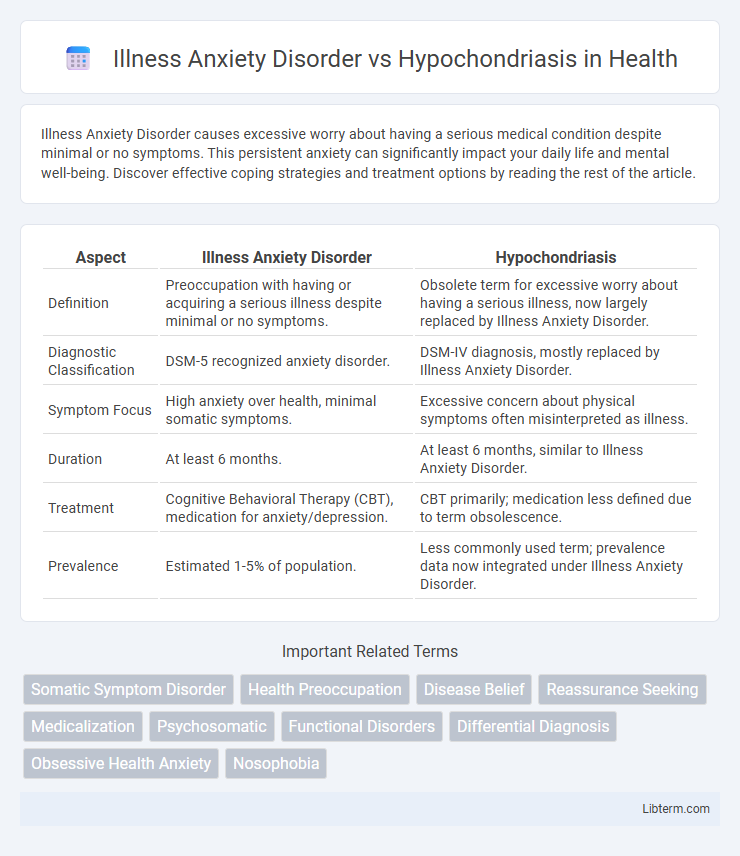Illness Anxiety Disorder causes excessive worry about having a serious medical condition despite minimal or no symptoms. This persistent anxiety can significantly impact your daily life and mental well-being. Discover effective coping strategies and treatment options by reading the rest of the article.
Table of Comparison
| Aspect | Illness Anxiety Disorder | Hypochondriasis |
|---|---|---|
| Definition | Preoccupation with having or acquiring a serious illness despite minimal or no symptoms. | Obsolete term for excessive worry about having a serious illness, now largely replaced by Illness Anxiety Disorder. |
| Diagnostic Classification | DSM-5 recognized anxiety disorder. | DSM-IV diagnosis, mostly replaced by Illness Anxiety Disorder. |
| Symptom Focus | High anxiety over health, minimal somatic symptoms. | Excessive concern about physical symptoms often misinterpreted as illness. |
| Duration | At least 6 months. | At least 6 months, similar to Illness Anxiety Disorder. |
| Treatment | Cognitive Behavioral Therapy (CBT), medication for anxiety/depression. | CBT primarily; medication less defined due to term obsolescence. |
| Prevalence | Estimated 1-5% of population. | Less commonly used term; prevalence data now integrated under Illness Anxiety Disorder. |
Understanding Illness Anxiety Disorder
Illness Anxiety Disorder is characterized by excessive worry about having a serious illness despite minimal or no physical symptoms, often leading to frequent medical consultations and health-related anxieties. Unlike Hypochondriasis, which traditionally emphasized observable symptoms, Illness Anxiety Disorder centers on the preoccupation with health and persistent fear of disease. Understanding this disorder involves recognizing the intense health-related fears and cognitive distortions that contribute to ongoing distress and impairment in daily functioning.
What Is Hypochondriasis?
Hypochondriasis, now classified under Illness Anxiety Disorder in the DSM-5, involves excessive worry about having a serious illness despite medical reassurance and lack of significant symptoms. This condition is characterized by persistent health anxiety and preoccupation with bodily sensations, causing significant distress and impairment. Understanding hypochondriasis requires recognizing its focus on fear and misinterpretation of normal bodily functions rather than actual illness.
Key Differences Between Illness Anxiety Disorder and Hypochondriasis
Illness Anxiety Disorder primarily involves excessive worry about having a serious illness despite minimal or no physical symptoms, whereas Hypochondriasis includes persistent preoccupation with specific symptoms and frequent physical complaints. Illness Anxiety Disorder emphasizes anxiety about health status without substantial somatic complaints, while Hypochondriasis historically encompassed both high health anxiety and detailed symptom focus. The diagnostic criteria for Illness Anxiety Disorder, as per DSM-5, replaced Hypochondriasis to separate cases with predominant health anxiety from those with somatic symptoms.
Overlapping Symptoms and Features
Illness Anxiety Disorder and Hypochondriasis share overlapping symptoms such as excessive worry about having a serious illness despite minimal or no medical symptoms, frequent health-related anxiety, and persistent preoccupation with bodily sensations. Both conditions involve repeated checks for signs of illness, avoidance of medical situations, and significant distress impacting daily functioning. Key features include high health-related anxiety, reassurance-seeking behaviors, and misinterpretation of normal bodily sensations as signs of severe disease.
Diagnostic Criteria and Changes in DSM-5
Illness Anxiety Disorder (IAD) in DSM-5 replaces Hypochondriasis with distinct diagnostic criteria emphasizing preoccupation with having or acquiring a serious illness despite minimal or no somatic symptoms. DSM-5 criteria for IAD require excessive health-related behaviors or maladaptive avoidance, and symptoms must persist for at least six months. Unlike Hypochondriasis in DSM-IV, which combined somatic symptom concerns and illness anxiety, DSM-5 separates Somatic Symptom Disorder and IAD to improve diagnostic specificity and clinical treatment.
Common Causes and Risk Factors
Illness Anxiety Disorder and Hypochondriasis share common causes including heightened sensitivity to bodily sensations and a history of serious illness either personal or within family. Risk factors often involve excessive health-related information exposure, pre-existing anxiety disorders, and significant stress or trauma. Both conditions may be exacerbated by tendencies toward catastrophic thinking and a pattern of frequent medical visits driven by fear of undetected illness.
How Illness Anxiety Disorder is Diagnosed
Illness Anxiety Disorder is diagnosed through a clinical evaluation emphasizing excessive worry about having or acquiring a serious illness despite minimal or no somatic symptoms, differentiating it from Hypochondriasis which may involve more evident physical complaints. Diagnostic criteria from the DSM-5 include preoccupation with health concerns lasting at least six months, high anxiety about health, and excessive health-related behaviors or avoidance. Physicians often rule out other medical or mental health conditions before confirming Illness Anxiety Disorder to ensure accurate diagnosis and appropriate treatment.
Treatment Approaches for Both Conditions
Illness Anxiety Disorder and Hypochondriasis treatment approaches primarily involve cognitive-behavioral therapy (CBT) to address excessive health-related fears and maladaptive thought patterns. Selective serotonin reuptake inhibitors (SSRIs) are often prescribed to reduce anxiety symptoms associated with both conditions. Consistent medical reassurance and psychoeducation help patients differentiate between normal bodily sensations and pathological symptoms, promoting long-term symptom management.
Coping Strategies for Patients and Families
Effective coping strategies for Illness Anxiety Disorder and Hypochondriasis include cognitive-behavioral therapy (CBT) to manage excessive health-related fears and reduce reassurance-seeking behaviors. Families can support patients by maintaining open communication, providing emotional reassurance without reinforcing anxiety, and encouraging adherence to treatment plans. Mindfulness techniques and stress management exercises also play a crucial role in alleviating symptoms and improving overall quality of life for both patients and caregivers.
When to Seek Professional Help
Persistent and excessive worry about having a serious illness despite medical reassurance signals the need to seek professional help for Illness Anxiety Disorder or Hypochondriasis. When health anxiety significantly disrupts daily functioning, causes distress, or leads to repeated medical visits without relief, consulting a mental health professional is crucial. Early intervention with cognitive-behavioral therapy or medication can effectively reduce symptoms and improve quality of life.
Illness Anxiety Disorder Infographic

 libterm.com
libterm.com